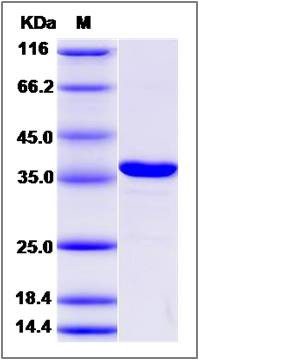Human CBR3 / HCBR3 / Carbonyl Reductase 3 Protein (His Tag)
hCBR3,HEL-S-25,SDR21C2
- 100ug (NPP1979) Please inquiry
| Catalog Number | P14632-H07E |
|---|---|
| Organism Species | Human |
| Host | E. coli |
| Synonyms | hCBR3,HEL-S-25,SDR21C2 |
| Molecular Weight | The recombinant human CBR3 consists of 292 amino acids and predicts a molecular mass of 32.7 KDa. It migrates as an approximately 37 KDa band in SDS-PAGE under reducing conditions. |
| predicted N | His |
| SDS-PAGE |  |
| Purity | > 90 % as determined by SDS-PAGE |
| Protein Construction | A DNA sequence encoding the human CBR3 (O75828) (Met1-Trp277) was expressed with a polyhistidine tag at the N-terminus. |
| Bio-activity | |
| Research Area | Cancer |Signal transduction |Metabolism |Pathways and Processes |Metabolic signaling pathways |Alcohol metabolism | |
| Formulation | Lyophilized from sterile 50 mM Tris, 10% glycerol, pH 8.0. 1. Normally 5 % - 8 % trehalose and mannitol are added as protectants before lyophilization. Specific concentrations are included in the hardcopy of COA. |
| Background | CBR3, also known as hCBR3, belongs to the short-chain dehydrogenases/reductases (SDR) family. CBR3 is expressed in ovary, pancreas, intestine, colon, kidney, brain, thymus, lung, heart, liver, spleen, leukocyte, prostate and testis. It is a monomeric NADPH-dependent oxidoreductase and is closely linked to another carbonyl reductase gene – CBR1. CBR3 catalyzes the reduction of a large number of biologically and pharmacologically active carbonyl compounds to their corresponding alcohols. It has low NADPH-dependent oxidoreductase activity towards 4-benzoylpyridine and menadione (in vitro). |
| Reference |
